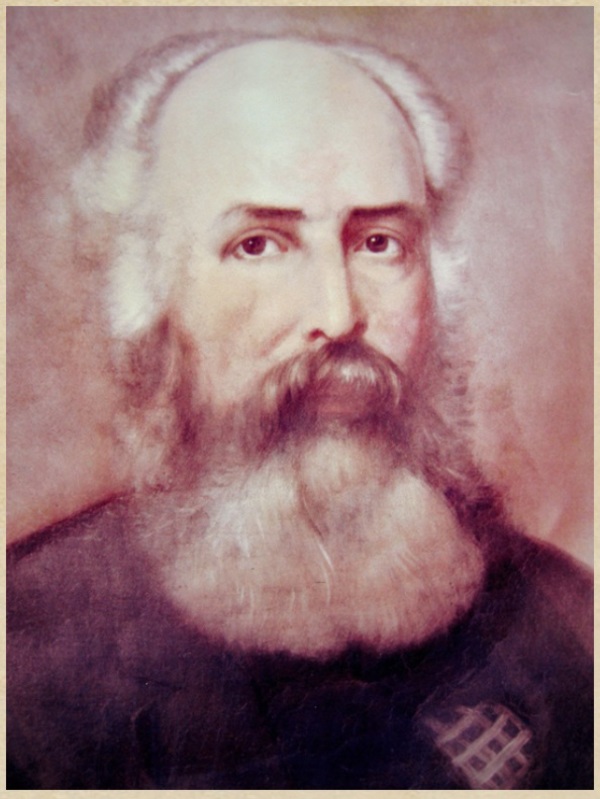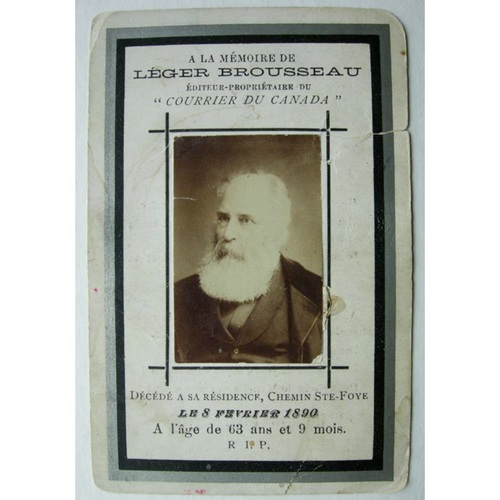
Source: Link
BROUSSEAU, LÉGER (baptized Joseph), bookseller, publisher, and printer; b. 21 May 1826 at Quebec City, son of Jean-Baptiste Brousseau and Nathalie Doré; m. first 12 June 1860 at Quebec Catherine Rose Bennett; m. secondly 27 Nov. 1866 Georgiana Garneau of Cap-Santé, Canada East, and they had ten children of whom three were still alive at the time of his death; d. 8 Feb. 1890 at Quebec.
Little is known about Léger Brousseau’s early life. He is thought to have learned the trade of typographer at the Quebec Mercury before entering into partnership with his elder brother Jean-Docile*; the elder Brousseau, whose bookstore and printing works were on Rue Buade, had been the official printer for the archdiocese of Quebec since 1855 and the owner of Le Courrier du Canada since 1858. Léger looked after the operation of the press and began using his name as publisher in 1861 when his brother embarked on a political career. He compiled the synodical and episcopal enactments of the diocese of Quebec, and in 1871 he published Le Journal des jésuites . . . , edited by abbés Charles-Honoré Laverdière* and Henri-Raymond Casgrain*. After the printing works burned down in 1872 copies of this latter work became extremely rare, as did those of Théophile-Pierre Bédard’s Histoire de cinquante ans (1791–1841), annales parlementaires et politiques du Bas-Canada, depuis la Constitution jusqu’à l’Union (1869). Brousseau undertook the second edition in 1876 of the Mémorial de l’éducation du Bas-Canada by Dr Jean-Baptiste Meilleur*, and also published school texts. He printed newspapers and journals: Journal de l’Instruction publique (1871–79), Journal of Education for the Province of Quebec (1872–79), and the Annales de la bonne Sainte-Anne-de-Beaupré from 1873. Having published the “Causeries du dimanche” by Judge Adolphe-Basile Routhier* in Le Courrier du Canada in 1870 and 1871, he made widely known Routhier’s judgement concerning the “undue influence” at the time of the 1876 election between Hector-Louis Langevin* and Pierre-Alexis Tremblay* in Charlevoix. He printed books and biographies by Stanislas Drapeau*, a prolix author, and published the numerous pamphlets of Narcisse-Eutrope Dionne*, a versatile writer whose inexpensive works sold well.
During the 1860s catechisms, pious pamphlets, and diocesan almanacs constituted the bulk of Brousseau’s sales to his ecclesiastical clientele, to whom he also supplied wine, registers, and stationery. From 1875, however, there was an increasing demand for souvenirs of retreats and pilgrimages, communion certificates, and holy pictures, all signs of a devotional revival. In 1880 Brousseau became the printer of the almanac of the diocese of Rimouski for a five-year period, and during these years his press seems to have functioned at maximum capacity, with orders booked four months in advance.
A member of the Cercle catholique de Québec and the Association des typographer de Québec, as well as an honorary member of the Union Allet of papal Zouaves in 1878, Brousseau was in the main a man who undertook charitable endeavours for the religious communities, to which he was asked to supply stationery free. Thanks to his good relations with Stanislas Drapeau and Joseph-Charles Taché*, who were federal officials, and with Langevin, a federal cabinet minister, he enjoyed considerable influence in Ottawa. More important, however, the fact that his brother-in-law, Pierre Garneau*, was a minister in the Quebec government from 1875 brought him printing contracts for the private and public bills of the legislature, the Statuts de la province de Québec, and the professional and municipal corporations. In 1880, during an era when conflicts of interest went unheeded, Brousseau received contracts from the city of Quebec for such items as notices and minutes of meetings during the tenure of his brother, Jean-Docile, as mayor.
During the 1860s the archdiocese of Quebec, through Vicar General Charles-Félix Cazeau, played a part in the editing of Le Courrier du Canada and also reserved the right to “approve” the editor, but in the 1870s Brousseau apparently had a free hand. In 1872 he purchased the paper and three years later dismissed reporter Guillaume Amyot because of an article in which he had drawn attention to the contracts awarded without tender by Quebec when Jean-Docile Brousseau was a member of the city council; in 1879 Amyot’s successor, Roch-Pamphile Vallée, was also relieved of his duties. At this prosperous stage in its development Le Courrier du Canada had a solid network of subscription agents, correspondents, and readers, even in the United States, but Brousseau did not consider any changes in the form of his paper. A tri-weekly edition was, however, added to the daily, and in 1882 he launched Le Journal des campagnes. From 1884 he seems to have gradually relinquished the task of publishing Le Courrier du Canada to Thomas Chapais* in order to become the Quebec agent of several renowned European publishers, including Desclée, De Brouwer et Compagnie of Bruges, Belgium, and Poursin-Escande and Gustave Guérin et Compagnie of Paris.
What Brousseau had built during his life was broken up soon after his death. On 27 Jan. 1891 Thomas Chapais acquired Le Courrier du Canada and Le Journal des campagnes for $6,000. In February Mme Brousseau, the sole heir, sold the bookshop and printing works to Léger Brousseau Jr for $22,000, but financial difficulties obliged him to sell it a few years later.
Léger Brousseau had made himself supplier to the clergy; official printer for two dioceses, the legislature, and the city of Quebec; and also an administrator who although punctilious allowed enormous credit to a touchy and neglectful clientele. He owed part of his fortune to favourable political and ecclesiastical circumstances and to improved communications and postal services. He owed his fortune also to his knowledge of his trade, his unremitting labour, and his ability as a businessman and publisher.
AAQ, CD, Diocèse de Québec, IX: 2ff.; 20 CG, II; 33CR, B: 19; I: 71. AC, Québec, État civil, Catholiques, Sainte-Famille (Cap-Santé), 1882; Minutier, P.-É. Bélanger, 3 avril 1890; 27 janv., 4, 19 févr. 1891; 12 juin 1897. ANQ-Q, AP-G-16; État civil, Catholiques, Notre-Dame de Québec, 21 mai 1826, 12 juin 1860; Sainte-Famille (Cap-Santé), 27 nov. 1866. BE, Québec, Reg. B, 162, no.82508. Le Canadien, 10, 13 févr. 1890. Beaulieu et J. Hamelin, Journaux du Québec, 185. Claude Poirier, “Inventaire analytique du fonds Léger Brousseau,” ANQ Rapport, 1972: 159–253. André Labarrère-Paulé, Les laïques et la presse pédagogique au Canada français au XIXe siècle (Québec, 1963). Réjean Robidoux, “Les Soirées canadiennes et le Foyer canadien dans le mouvement littéraire québécois de 1860” (thèse de des, univ. Laval, Québec, 1957). Elzéar Lavoie, “La clientèle du Courrier du Canada,” Culture (Québec), 30 (1969): 299–309; 31 (1970): 40–57. Romain Légaré, “Apôtre de l’Évangile au Canada,” Le Souvenir (Trois-Rivières), 17 (1970), no.1: 4–10. Raoul Renault, “Le journal des jésuites,” BRH, 5 (1899): 52. Philippe Sylvain, “Les débuts du Courrier du Canada et les progrès de l’ultramontanisme canadien-français,” Cahiers des Dix, 32 (1967): 255–78. R. G. Thwaites, “Le journal des jésuites,” BRH, 5 (1899): 22.
Cite This Article
Elzéar Lavoie, “BROUSSEAU, LÉGER (baptized Joseph),” in Dictionary of Canadian Biography, vol. 11, University of Toronto/Université Laval, 2003–, accessed December 29, 2025, https://www.biographi.ca/en/bio/brousseau_leger_11E.html.
The citation above shows the format for footnotes and endnotes according to the Chicago manual of style (16th edition). Information to be used in other citation formats:
| Permalink: | https://www.biographi.ca/en/bio/brousseau_leger_11E.html |
| Author of Article: | Elzéar Lavoie |
| Title of Article: | BROUSSEAU, LÉGER (baptized Joseph) |
| Publication Name: | Dictionary of Canadian Biography, vol. 11 |
| Publisher: | University of Toronto/Université Laval |
| Year of publication: | 1982 |
| Year of revision: | 1982 |
| Access Date: | December 29, 2025 |




